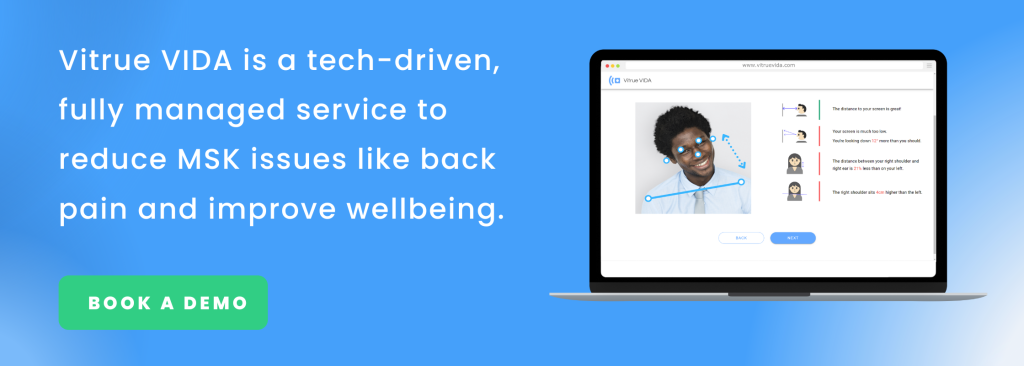The Health and Safety (Display Screen Equipment) Regulations 1992 exist to protect desk workers from the health risks associated with using devices such as computers, laptops, tablets and smartphones (DSE) for extended periods of time.
Under the DSE regulations, employers have a duty of care to ensure their employees are set up to work safely in line with specific guidelines. If your team use DSE for more than an hour at a time every day, you are legally required to:
- Carry out workplace assessments, including desk setup, equipment and furniture
- Provide training and information to help employees minimise the risks of DSE work and adopt safe working practices
- Make sure your team’s work routines include breaks from DSE work
- Provide eye tests if requested
A study carried out by Specsavers revealed that less than 50% of employers fully understand DSE and desk assessment regulations and only 30% are in full compliance.
If you don’t follow and enforce the DSE regulations, your team may slip into all kinds of bad working practices such as staring at a screen for hours at a time, poor desk posture and incorrect workplace setups. All of these have the potential to snowball into much greater problems such as:
1. Musculoskeletal (MSK) Issues
What is MSK? Your musculoskeletal system includes bones, muscles, tendons, ligaments and soft tissues which work together to support your body’s weight and help you move. An MSK issue is any problem that prevents this system from functioning correctly, affecting the way you move.
DSE users have an increased rate of musculoskeletal issues like neck and back pain, most commonly caused by poor posture and incorrect screen positioning placing increased stress on the neck and back.
On average, 2.6% of a workforce will require time off work for musculoskeletal issues each year. Issues like chronic back pain can stop you from doing the things you love, whether that’s taking part in your favourite sport or playing with your kids.
The most common musculoskeletal issues in DSE users are back pain, neck pain and shoulder pain, but there is a wide spectrum of other potential problems including:
- Carpal tunnel syndrome – resulting from repeated hand or finger movements when the wrist is bent
- Tendonitis – overuse of tendons leading to inflammation and pain
- Epicondylitis – commonly known as ‘tennis elbow’, caused by overuse of the muscles in the lower arm which are attached to the elbow
- De Quervain Syndrome – a form of RSI caused by the frequent use of the thumbs to press buttons, common with overuse of smartphones
65% of employees report some level of work-related pain, but a good ergonomic workspace setup can protect and maintain your team’s musculoskeletal health.

2. Stress and Mental Health Issues
It’s widely accepted that physical and mental health are closely intertwined, so a deterioration in a person’s physical health can have harmful effects on their mental wellbeing.
Musculoskeletal pain can often result in psychological distress, leading to the development of depression and anxiety. Depression is four times more common in people with chronic pain compared to those without pain. 615 million people suffer from depression and anxiety worldwide, costing the global workforce an estimated $1 trillion in lost productivity each year.
Working long hours without breaks can also dramatically increase a person’s chances of developing burnout and work-related stress. 75% of people have experienced burnout at work, with 40% saying they’ve experienced burnout specifically during the pandemic. The DSE guidance around frequent breaks and training can protect your team from falling victim to these conditions.
3. Visual Fatigue
Many desk workers experience visual fatigue if they stare at screens for long periods of time without breaks, or work in areas with poor lighting or glare.
This can lead to a range of symptoms such as:
- Impaired visual performance (e.g. blurred vision)
- Red, sore or tired eyes
- Headaches
- Temporary short sightedness
Visual fatigue can also make someone aware of eyesight problems they hadn’t noticed before and amplify any pre-existing issues.
Did you know? A study by Specsavers revealed that many employers think eye tests are more costly than they actually are. It’s possible to purchase vouchers to cover both the full eye test and glasses for just £17 at some suppliers, so looking after your team’s visual health doesn’t need to be a costly affair!
4. Legal Implications
If you don’t follow and comply with the DSE regulations, you are breaking Health and Safety law. You’re also putting yourself at risk of personal injury lawsuits if an employee sustains a workplace injury caused by poorly designed workstations or defective equipment.
If it can be proven you were negligent in providing a safe working setup, and this was the cause of an employee’s pain and injury, they will be able to make a hefty compensation claim:
- A freelance journalist working for a national newspaper was able to claim £37,500 for a repetitive strain injury she incurred working an average of nine hours a night, as no risk assessment was undertaken at the start of her employment. When she developed stiffness and pain in her elbow, the HR department refused to help as she was not a permanent member of staff.
- A German court ruled that a man who slipped whilst walking from his bed to his home office could claim on workplace accident insurance. The act of climbing the stairs to his home office was synonymous with the morning commute and therefore counted as a business route. This case reinforces the fact that an employer’s duty of care extends to the home for remote and hybrid workers.





